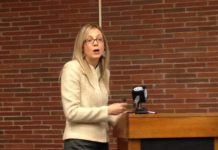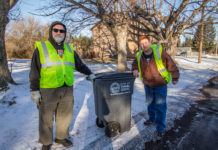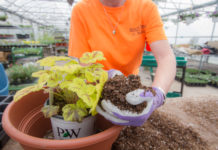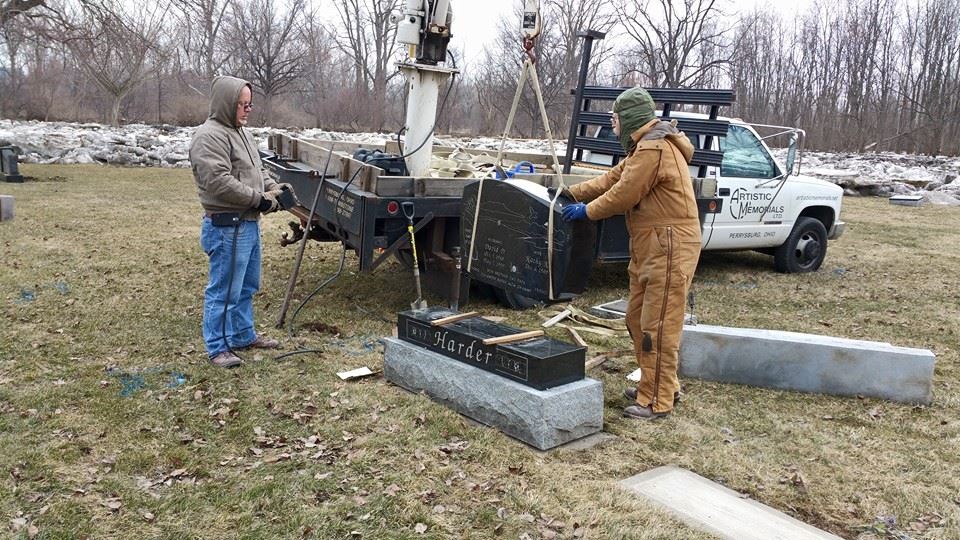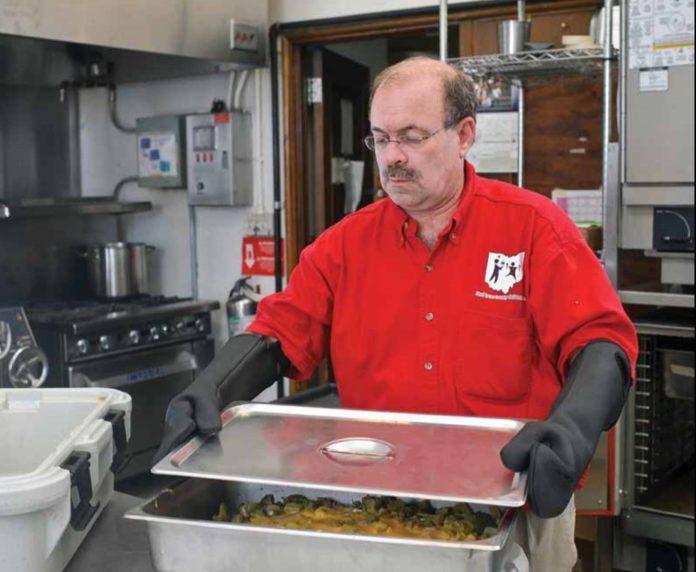
It’s 11:30 on a Tuesday morning, and children are starting to trickle in to the Believe Center in South Toledo.
They’ve just returned from the library, and sit at tables in the Believe Center’s cafeteria, poring over the worksheets they got there. Teenagers sit by and help the kids as needed with the reading.
Then, finally, it’s lunchtime.
The Believe Center is one of 86 sites served by Feed Lucas County Children (FLCC), a nonprofit started by Tony Siebeneck with the goal of providing nutritious meals to the 33,000 children in the county who live below the poverty line.
Founded in 2002, Siebeneck, a former agronomist, started the charity in 2002 after reading an article and then researching child hunger in the area.
“After nine months of grassroots research, I found out that the problem was a lot worse than what I was reading about. In life, we have more people that are talkers than doers about problems. We are not talkers, we are doers. To me, people talk about things, but they really have no intentions about doing something to help others. I do,” Siebeneck said.
Home base
FLCC is based in the old Macomber High School building on Monroe Street. Here, all the food is cooked, and is then taken or picked up to be distributed at one of FLCC’s sites.
On any given day, the place is bustling. Vans from the feeding sites, which range from churches to apartment complexes to parks, are loaded with food for delivery. Volunteers in red shirts move about the warehouse-like space, moving bins of food to their correct spot in rows of movable metal shelves. Coolers are stacked at the back of the large room.
It’s clear that the charity is running out of space.
Siebeneck’s office is next to the kitchen. Awards and newspaper clippings line its walls, sharing space with large checks from corporate sponsors such as Walmart and GM Powertrain. He shares the office with a small number of paid part-time employees.
Siebeneck himself flits about the office with vigor, seemingly tackling many tasks at once. He quickly takes care of a volunteer’s request for a gas card, and then takes a phone call: an employee has car trouble. Siebeneck remains nonplussed.
“Ten years ago, there was no organization in this county that was committed to reaching out to more kids in need, especially during summertime,” he said. “I’m an agronomist. I worked with plants, plant diseases, plant bacteria, viruses. I worked in the ag industry. I worked with the raw food end of it. What I did was help educate the public in what they call more sustainable agriculture. I did that for many years as a career, as an agronomist, and it was very rewarding. But when I discovered that there was this many kids going without — let’s put it this way: You’re only on Earth for so long, but I’m a firm believer that you have to give back to others but you never know when it might be your turn … that’s what life’s all about.”
FLCC is not a faith-based organization, but Siebeneck is a committed Catholic who laughingly calling himself a “fish-eater.” As a result of his community outreach, Siebeneck is often invited to different church services to speak.
“Sometimes my wife will ask me, ‘What are you tomorrow?” tomorrow being Sunday. I’m Methodist, I’m Baptist, I’m Presbyterian. I do enjoy that, going to different church services. It’s kind of neat, the different things you learn, see, and hear,” he said.
Siebeneck has been married to wife Therese for 26 years. They have four children: Matthew, 25, Luke, 24, Emily, 23 and Paul, 21. All four were in college at the same time at one point.
“We are very fortunate, a very healthy family, good kids. They’ve stayed out of trouble,” he said.
Siebeneck was born and raised on a dairy farm in Indian Lake, Ohio, and he can deeply relate to much of the work he does today.
“When I grew up, I know what it was like being hungry, too. I’ve been there myself. My parents separated when I was 9 years old, and even though I was so active in the farm operation, I lived with my mother and three other siblings,” he said.
Siebeneck got his first job at 12 years old to support his mother, who received little in the divorce settlement. He and his older brother Carl have been taking care of her mother ever since; today, she is 95 and in the early stages of Alzheimer’s disease.
Feeding the children
“The children that we feed are the ones receiving free or reduced lunches in school. When school lets out for the summer, but there are no school meals. I don’t know about you, but I don’t think kids quit eating when the summer comes. What we do is bridge that gap from child hunger from the time school stops to the time school starts in the fall,” Siebeneck said. “We have so many wonderful people in this county. Around Thanksgiving and Christmas there’s a lot of people that give, but the general public doesn’t realize that the needs are greater in the summer than they are in the winter.”
Toledo is rated the seventh worst city in the country in terms of hunger.
“Some people don’t want to know about hunger, but it’s like lava … it’s just flowing out there. Everyone thinks that in the inner city in Toledo, that’s where the hunger’s at, but we are feeding kids from either side of this county,” he said.
Each day, FLCC provides kids with up to two meals a day at any given site. Children who show up for food get more than just a nutritious meal.
“What we like to do is embrace food with educational components during the summertime. Many of these sites will have some type of activity or educational aspect. It could be physical fitness, reading, math, or just taking that kickball outside and giving them something physical to do,” Siebeneck said.
The majority of the sites run fives days a week, but some are functional for seven.
FLCC is able to keep its 86 sites open by partnering with organizations like the Believe Center to spread the word and draw in children.
“What we hear every year— heaven forbid — is that if Feed Lucas County Children ever stopped feeding the children, that all those organization would lose their foundation that drives kids to these programs … food draws kids. If they’re hungry, they come. It’s almost like entrapment, they come to eat, and while they’re here, you’re going to learn something,” Siebeneck said.
Stephen Goldman, professor emeritus of University of Toledo, is one of the members of FLCC’s board of directors.
“In the few years we have been in place, we have provided a million meals to poor children. The meals we have provided are well-balanced, nutritious, and at no cost,” Goldman said.
Siebeneck said that serving healthy food was the goal from the start.
“There is no fried food. We steam the majority of the food that we serve, which is very rare out there. We operate the largest hot, balanced meal program in the state,” Siebeneck said.
In the main kitchen at Macomber, one main chef prepares up to 7,200 meals a day, with the force of the 200-some FLCC volunteers. Most of the volunteers heard of the program through word-of-mouth or through visibility at the sites. Volunteers are trained, even on site, and are monitored.
Dorothy Thomas is a new volunteer at Beatty Park.
“Children need food. I’ve been with the football team [the Mid City Spartans] for the last couple of years. A lot of times, kids come out there and they haven’t eaten or they might go home and not have anything to eat. This program is very beneficial to them,” she said.
Jessica Robinson, 18, helps feed and supervise the kids at the Believe Center. She benefited from the program as a child.
“It’s good, they feed you good,” Robinson said.
Each FLCC site’s schedule is suited to its location.
“Each site is especially design to fit what that neighborhood’s trying to do. Some sites serve breakfast and lunch, some lunch and a snack in the afternoon (after physical activities). Some places serve a dinner. We are in a lot of the parks at night. It works out well, unless it rains. We have been pounded by rain this summer, and that makes it a little more difficult. But we just keep pushing and keep going,” Siebeneck said.
Siebeneck stressed that while parental education is important in improving the feeding habits of their children, simple seminars don’t work.
“You can’t show up in a coat and tie and have a meeting with neighborhoods and then walk away. Meetings don’t feed children,” he said.
FLCC’s efficiency and personalized planning pays off. It serves twice as many children as averaged by similar programs across the nation.
“Washington is looking at our food model right now … and there’s a possibility that our food model will be copied and used in different states,” Siebeneck said.
Dire need
As Siebeneck and his employees are fighting to end child hunger, they face another massive hurdle: They need a new kitchen facility to prepare their food, and fast.
“Right now, we are in desperate need of expanding this kitchen. We can feed more kids if we can get more cooking equipment and more space. As soon as we can hit our goal with this expansion project, Lucas County will be the first county in the state of Ohio to end summer hunger,” Siebeneck said.
FLCC has never publicly solicited donations, and Siebeneck stresses that the current fundraiser is a “one-time deal.”
“This is the one time we really need the public to step up to the table between now and Christmas, to see this kitchen be made a reality,” he said.
The new kitchen facilities will cost from $800,000 to $1.3 million.
“I have confidence, and I am a firm believer, that as soon as the community finds out the situation that we’re in, that we are going to get through this problem. This project is so tangible and transparent: the money is going to go into space and cooking equipment and food that feeds children. I don’t think anybody could find a better cause right now,” Siebeneck said.
Awareness Family Festival
For its first large-scale fundraising event, FLCC is hosting the Hunger Awareness Family Festival from 2-9 p.m. July 27 at the field on the corner of Centennial and Brint roads in Sylvania.
“Dr. Carol Bennett-Clarke at UT, one of the medical professors, and 24 of her medical students came out a month ago with me … and we painted the largest MyPlate in the U.S. It’s a half-acre big, on a tarp,” Siebeneck said.
The MyPlate is a government-issued graphic that depicts the suggested proportion of fruits, vegetables, grains, dairy and protein on a person’s plate and cup.
Squares were painted onto the half-acre MyPlate. For the fundraiser, FLCC is selling each square for $40. A helicopter will throw assorted food items from above onto the grid, with a cash prize for the owners of the squares the food lands on. Also, the helicopter will toss down 50 T-shirts.
The Hunger Awareness Festival will feature food and live music, including performances by Abby Ray and Distant Cousinz. Ray wrote a special song about hunger for the festival.
FLCC will also hold a Twylite Thursday fundraiser at The Pinnacle on Aug. 15.
Siebeneck, the man who has served 1.3 million meals to hungry children, doesn’t mince words when it comes to the adeptness of his charity.
“Ninety-three percent of every dollar we get goes back to the program. That’s very high. We don’t take a backseat to anybody when it comes to efficiency,” he said.




